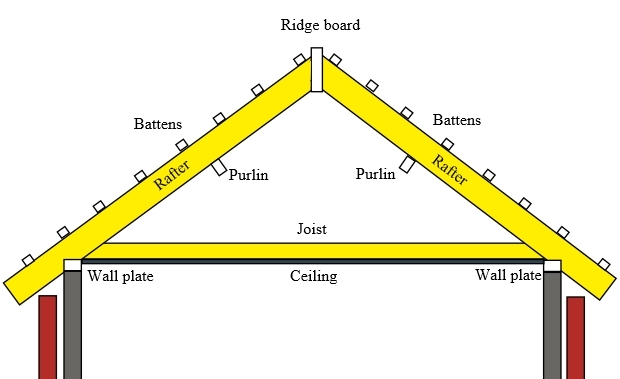Rafter

|
A rafter is a structural component that is used as part of a roof construction. Typically, it runs from the ridge or hip of the roof to the wall plate of the external wall. Rafters are generally laid in series, side by side, providing a base to support roof decks, roof coverings and so on.
Rafters are typically made of timber or steel and can be concealed within the roof structure, or can be left exposed to the spaces below. The may have battens laid on top of and perpendicular to them, to fix the roof covering to.
Rafters can be used as a key component of various types of roof design. The couple roof comprises two rafters leaning against each other, tied where they meet at the top. The rafters sit on a wall plate which is an efficient means of spreading the load exerted by the roof structure down through the walls without creating pressure points where each rafter meets the wall.
A closed couple roof adds ceiling joists running horizontally between the rafter feet, to support a ceiling and to make the structure much more rigid.
In order to increase potential roof spans without compromising wall stability, increasing rafter sizes or attracting extra costs, purlins were introduced. These run perpendicular to rafters, providing additional stiffness. By installing a purlin into the roof structure, rafters no longer needed to be as thick and heavy, allowing larger potential spans.
In modern house construction, the most common form of rafter is known as the fink or 'w' trussed rafter. This consists of a rafter incorporating tension and compression members in the shape of a W. This is capable of spans up to 12 m and can be designed to accommodate many different pitch angles.
For more information see: Trussed rafters
The most common types of rafter include:
- Principal rafter: Usually the largest type of rafter located at the ends of a roof structure.
- Common rafter: Smaller rafters located in between the principals at both ends.
- Auxiliary rafter: Less common but can be used to support and reinforce a principal rafter.
- Compass rafter: Curved or bowed at the top or at both the top and bottom surfaces.
- Curb rafter: The upper rafters in a gambrel or Mansard roof.
- Hip rafter: Smaller rafters used for the corners of a hip roof.
- King rafter: On the side of a hip roof, a king rafter is the longest and is in line with the ridge.
- Valley rafter: The main rafter that is found at the lowest point of a valley roof.
- Jack rafter: A rafter that is shortened by landing on a hip rafter or being interrupted by a dormer window.
- Barge rafter: On a gable end this is the outermost rafter and is sometimes used to form a roof overhang.
[edit] Related articles on Designing Buildings Wiki
Featured articles and news
Infrastructure that connect the physical and digital domains.
Harnessing robotics and AI in challenging environments
The key to nuclear decommissioning and fusion engineering.
BSRIA announces Lisa Ashworth as new CEO
Tasked with furthering BSRIA’s impressive growth ambitions.
Public buildings get half a million energy efficiency boost
£557 million to switch to cleaner heating and save on energy.
CIOB launches pre-election manifesto
Outlining potential future policies for the next government.
Grenfell Tower Inquiry announcement
Phase 2 hearings come to a close and the final report due in September.
Progress from Parts L, F and O: A whitepaper, one year on.
A replicated study to understand the opinion of practitioners.
ECA announces new president 2024
Electrical engineer and business leader Stuart Smith.
A distinct type of countryside that should be celebrated.
Should Part O be extended to existing buildings?
EAC brands heatwave adaptation a missed opportunity.
Definition of Statutory in workplace and facilities management
Established by IWFM, BESA, CIBSE and BSRIA.
Tackling the transition from traditional heating systems
59% lack the necessary information and confidence to switch.
The general election and the construction industry
As PM, Rishi Sunak announces July 4 date for an election.
Eco apprenticeships continue help grow green workforce
A year after being recognised at the King's coronation.
Permitted development rights for agricultural buildings
The changes coming into effect as of May 21, 2024.





















